Standard? Standard? Does anyone have the standard?
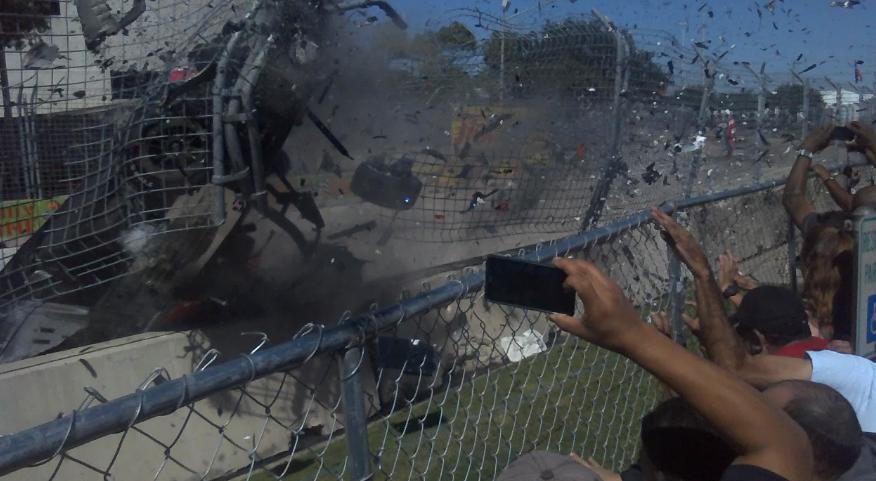 |
| Dario Franchitti rips the Houston fencing to shreds |
Very few people are talking. The few who are, aren't offering much of substance, choosing instead to speak in broad generalities, and overwhelmingly expressing relief that the outcome was not worse.
And who could disagree.
When Dario Franchitti made contact with Takuma Sato on the final lap in Race 2 of The Shell and Pennzoil Grand Prix of Houston, and was launched airborne into the catch fence his impact with the catch fence shattered his Dallara DW 12 Honda to pieces.
Thankfully, we saw the four-time IndyCar Series champion moving in the car shortly after coming to a rest. We were then given further reassurance that the worst had not occurred when his team owner Chip Ganassi gave a thumbs-up on his drive back from the accident scene. Franchitti, ultimately did suffer two broken vertebra, a broke ankle, and a concussion, but was transported back to Indianapolis late last week, and appears to be in good spirits.
Without restating the obvious, we are all thankful for that. And on behalf of everyone here at AutoRacing1.com, I would like to wish Franchitti a speed recovery.
Of course, thirteen spectators did also incur minor injuries as part of the catch-fence detached and went flying into an area of spectators. Like Franchitti, we are again thankfully the spectator injuries were far less serious than they could have been, as all but two of the injured were treated at the track and shortly released.
And while it is not reassuring that pieces of the fence became projectiles, the catch-fence did absorb the impact of a 1500 lb. object travelling around 150 miles per hour, yet managed to said object within the confines of the racing area, preventing the worst from occurring. That alone is a monumental testament to human achievement, and those who design race cars, and other safety components such as seat belts and head restraints.
Still, the events of Houston, in particular the catch fence coming apart, cannot simply be dismissed as having "dodged a bullet."
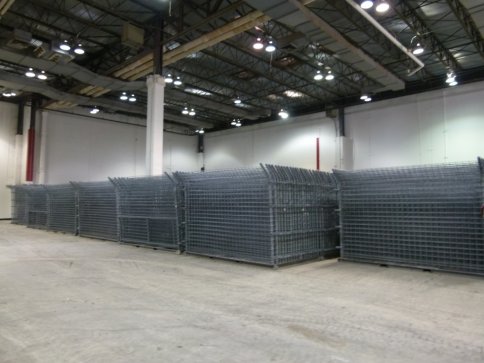 |
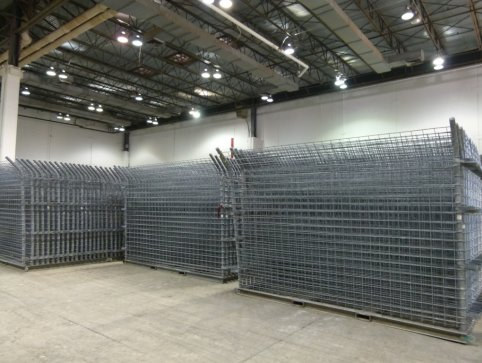 |
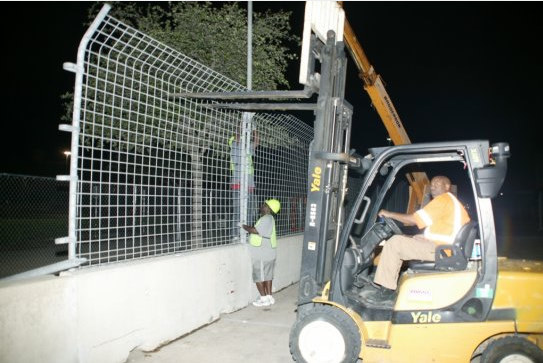 |
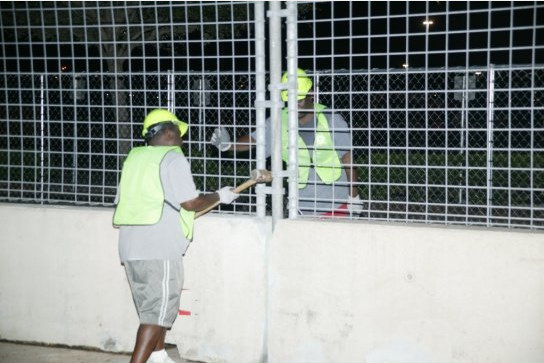 |
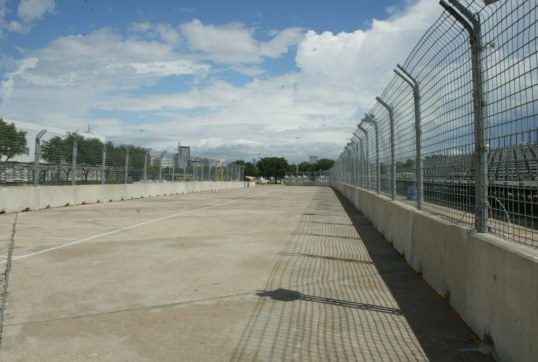 |
| Houston fencing from warehouse to construction |
For obvious reasons, projectiles flying into spectator areas raise huge concerns for not only racing but IndyCar. Again, while we're thankful Franchitti's injuries were not worse, spectator injuries were minor, taking solace in that simply will not suffice, as spectators were endangered at Houston to a degree I would contend is not reasonable.
Now, I want to be very clear, the intent of this piece is not to assign blame, or find fault. Rather, this is meant to be a neutral analysis of the accident, acknowledging a very harsh reality Franchitti's accident reminded us of: the sport we love is an incredibly dangerous that will never be made 100% safe.
But considering the endangerment of spectators, which occurred due to the catch fence coming apart, an analysis is warranted.
It all starts with a cost/benefit analysis:
Without sounding overly simplistic, safety at race tracks always has, is and always will be a cost/benefit tradeoff. Logically, the safest materials are the most expensive, and promoters, sanctioning bodies and the like make reasoned decisions with regard to the cost involved with safety equipment.
For example, the SAFER barrier is at nearly all oval tracks nowadays, yet does not cover every inch of wall at many. One of the few in which it does cover the entire outside retaining wall, Iowa, is only 7/8-mile long. The Indianapolis Motor Speedway, which is 2.5-miles in length has the SAFER barrier in select areas of the outside retaining wall, but not over the entire 2.5 miles.
Simply put, outfitting all of IMS with the SAFER barrier, is more expensive than Iowa for obvious reasons.
Continuing with the illustration of the Safer barrier, we've witnessed this of late with regard to the litany of accidents in sprint car racing, in which the race tracks were not equipped with the SAFER barrier. Whereas facilities like Iowa and IMS, which host larger racing series, thus generating more revenue, can afford the SAFER barriers, I presume many smaller dirt tracks cannot.
In short, not every race facility is always going to have the latest and greatest safety installments for the simple reason of the costs involved. This isn't changing.
Fair enough. But what about the Houston track? How was it configured in terms of modern race-safety standards?
It's hard to draw any definitive conclusions, from what has been said. But there is data indicating that the Houston track was not outfitted with safety equipment on par with a typical IndyCar race.
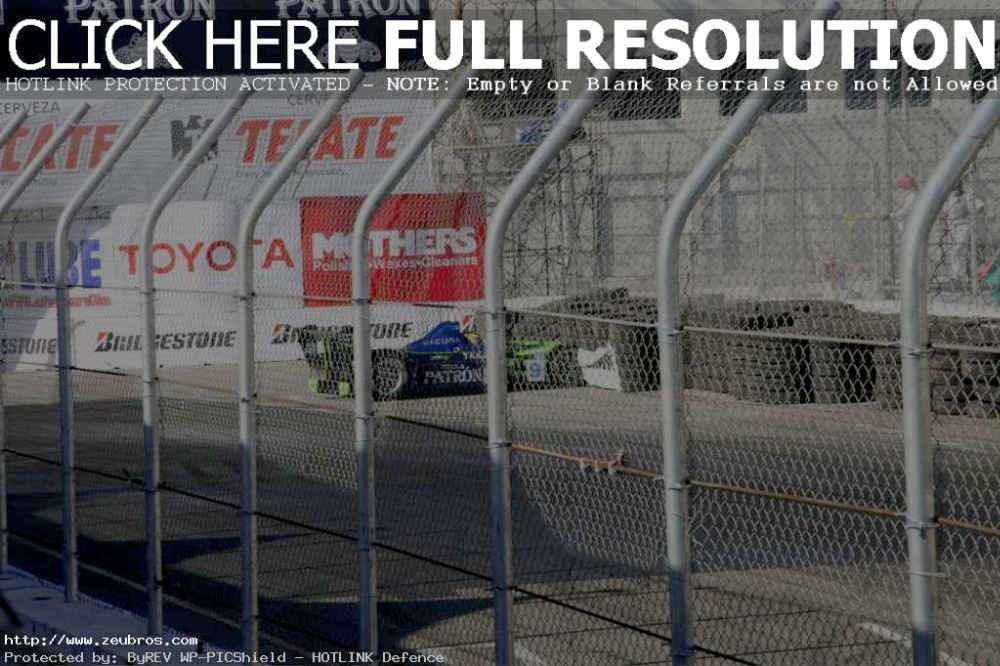 |
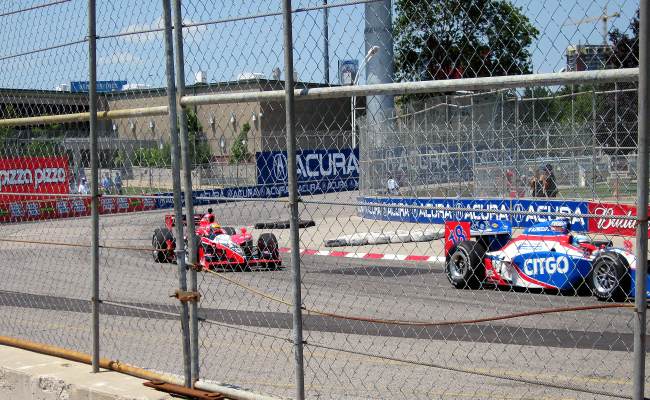 |
| Long Beach (Top) and Toronto (bottom) have horizontal cables but the strength of the fence mesh is much less than the Australia-like fence used in Houston |
Take a brief look at fencing from other IndyCar races would lead one to believe the fencing material used in Houston was not the best available. While there are other examples I can give of this, allow me to reference you to the pictures right from Long Beach and Toronto, you will notice horizontal cables. Unlike St. Pete, Long Beach, and numerous oval tracks, horizontal cables did not support the "mesh" portion of the fence at Houston.
How does the presence of horizontal cables improve safety?
Horizontal cables help dissipate the energy and g-load on the car by stretching it over a longer (read horizontal) distance. These cables likewise help keep the car inside the post pushing it back toward the track. Also, because the cars often launch into the fence with horizontal momentum, those cables essentially channel the car's momentum as a means of further dissipating energy.
Another consideration here is the numerous strands of cable. In essence, if one or more cables fail, there won’t be failure in all the cables protecting the integrity of the fence.
In short, presuming all other materials are equal and sound, the presence of horizontal cables minimizes the potential risk for the driver. A very good illustration of the effectiveness of the horizontal cables would be the video of Mike Conway's 2010 accident at Indianapolis, when he became airborne exiting turn-3 after running over the rear-wheel of Ryan Hunter-Reay who had run out of fuel.
So would the presence of horizontal cables have helped keep the fence intact?
Again, there are variables here.
But presuming all other materials are equal, cables would have raised the chances of the fence staying intact simply from the standpoint of dissipating energy. And by spreading the energy out over a longer impact area, one particular area would have absorbed less force increasing the chances one area would snap.
Keep in mind the "mesh" portion of the fencing broke. While the mesh material is strong, that strength can work against it from this respect: if enough pressure is placed on the mesh to where it is forced to break, it will snap, and become a projectile, as happened at Houston, placing spectators in a helpless position.
Now, the horizontal cables do not completely prevent this from happening but go a long way to keeping the fence intact. Because the cable is designed to stretch and give, while at the same time keeping the car inside the track, it relieves pressure on the fence, decreasing the likelihood it will snap.
So, by the above logic, it appears the fencing at Houston was not the best available safety device?
Yes. But more on that below.
Do, we know who built the fence?
No.
We know Geobrugg AG, a Swiss based company, which "develops and produces netting and mesh made from high-tensile steel wire for technologically mature geohazard solutions," including race tracks, did not build the fence. Geobrugg, for example, built the catch fence at Circuit of the Americas and claims on their website:
"The Geobrugg Debris Fence is FIA-approved for Grade 1 circuits, and is the only fencing system worldwide that is fully designed to provide the highest safety, best spectator viewing, and incredible installation speed by virtue of its optimized material and design. It is a cost-effective solution for racing circuits of all types and sizes."
We likewise know that Houston-based D3 Motorsport Development, a leading builder of temporary race circuits and the materials that accompany such circuits, claimed they did not build the fence, releasing a statement Tuesday on their Facebook page.
“On investigation into the events in Houston D3 has discovered and can confirm that the Debris Fence used in Houston is not a D3 Motorsport Development / D3 Industries Debris Fence. This fence is a inferior product that has been copied using an inferior steel quality and size. Track builders in the USA have been copying D3 products every since they saw them used in Surfers Paradise, Australia in 1991. D3 can also confirm by looking at race highlights and reviewing the FIA guidelines that the track did not meet FIA Grade 2 standard."
In short, we don't know who actually built the fence, and I can maybe surmise why no one is raising their hand and staking claim to it.
Both, Geobrugg and D3 cite FIA Grade standards? What does that mean?
The particulars of FIA Grade 1 and 2, are not entirely known. I imagine part of this is deliberate, as they allow for some variation from circuit to circuit. For example, would it stand to reason that Monaco is not as safe than a recently built Hermann Tilke circuit? Maybe.
However, all Formula 1 circuits must adhere to FIA Grade 1 standards. These things include sufficient run off area, sufficient pit entry/exit, no straightaway longer than 2 kilometers, and certain standards of safety fencing.
Grade 2 is considered the standard necessary for an FIA-sanctioned event in single seater cars, sports cars, and other formula below F1. By that logic, IndyCar circuits would need to adhere to Grade 2.
Other circuits for lower formula, have lower FIA Grade requirements.
Do IndyCar circuits need to adhere to a certain FIA standard?
Good question.
IndyCar sanctions races for the Izod IndyCar Series, Firestone Indy Lights, Pro Mazda and US F2000 Championship presented by Cooper Tires. The FIA sanctions series such as the FIA Formula One World Championship, FIA World Touring Car Championship and others, but not the Izod IndyCar Series.
Now, IndyCar has a connection with the FIA as do most racing organizations worldwide through a domestic entity, the Automobile Competition Committee (ACCUS), in the United States. The primary role of ACCUS seems to be that of issuing FIA licenses to its member organizations in America: Grand-Am, IndyCar, USAC, NHRA, and NASCAR fall under this umbrella.
A good example of ACCUS' role with regards to IndyCar can be illustrated through A.J. Allmendinger's failed drug test last season. Allmendinger, who failed a NASCAR-administered test, was immediately suspended and had his FIA license, which presumably was issued through ACCUS, suspended. Thus, Allmendinger could not compete in IndyCar, NASCAR, or any other form of motorsport requiring an FIA license, again issued by ACCUS in America, until reinstatement.
So, what role does ACCUS have with IndyCar "events," specifically?
Another good question.
Clearly, the issuance of FIA licenses is the primary role of ACCUS. And a license issued by ACCUS, or another such auxiliary of the FIA, is transferrable from nation to nation, which I suppose allows for participation of drivers from throughout the globe.
But does ACCUS have a hands-on role in setting up specific race courses?
It doesn't seem that way. Heck, it doesn't even seem IndyCar has as large a role in setting up for its events as we may have thought.
For one, judging by the differences from race course to race course that we saw earlier, it doesn't seem that INDYCAR applies universal standards of any kind to IndyCar races, something Houston seems to provide evidence for this.
Keep in mind, IndyCar president of competition Derrick Walker's quote to Robin Miller noting that IndyCar could make suggestions about the location of spectator seating, however, promoters had the final say.
Of course, the spectator area in question at Houston was located on the outside of a high speed bend in the track, at a point that would have been cause for concern if a car were to get airborne.
What I take from that is IndyCar does not have terribly firm rules that it requires of promoters to host an event.
I would also ascertain from that, that ACCUS doesn't exactly make stringent demands of IndyCar.
So, it seems IndyCar is blasé about overseeing races; ACCUS is blasé about IndyCar, and the FIA is blasé about overseeing ACCUS?
Judging by Houston? Yes.
So if IndyCar doesn't adhere to FIA Grade standards, and ACCUS doesn't really demand that IndyCar, what is the big deal about FIA Grade Standards?
Practically speaking, such standards probably makes races easier to insure. The FIA has an established track record of administering motor racing events, and claiming that a facility is in-line with a certain FIA Grade makes the race easier to insure.
But in actuality it comes down to two words: perception and credibility.
For example, say there was a spectator fatality and the Houston event had the finest FIA Grade material in place. Theoretically, the promoter and/or IndyCar could say every precaution was taken and a freak occurrence happened. The whole argument that well, "it will never be a 100% safe sport," would in that case, have greater weight.
Also, while it is unlikely that the claim of a safety contraption adhering to FIA-Grade standard would carry any weight legally, it would carry weight from a perception standpoint. INDYCAR and/or the promoter would be able to claim that the facility, like all other INDYCAR sanctioned events, was in accordance with FIA Grade 1 or 2 standards. But no one is making such claims with respect to Houston.
Plus, the fact IndyCar didn't exactly conduct a clinic at Houston in world-class event management doesn't help on the perception front. Yes, whether it was the delays caused by the unprepared track surface, the Mickey Mouse chicane that was added, the many caution periods, the botched pole award when Scott Dixon did the Verizon P1 ceremony, yet was stripped of the pole after someone read the rulebook, or a host of other factors that made Houston 2013 the s***show it was, IndyCar did not exactly have a host of shining moments to fall back on when the fence came apart.
Was there any gratuitous failure or negligence from any party?
I don't think so.
Definitively, we can say there was oversight either with regard to track design or the location of spectator seating (which included handicapped seating) in a high speed area. Also, there was clearly a decision made, for whatever reason, to not have the latest and greatest safety fencing in place.
So, what does all of this mean?
Without trying to sound like a broken record, this strikes me as another instance, highlighting a general lack of foresight and attention to detail within the IMS/IndyCar/Hulman and Co. enterprise. We realized in Houston that IndyCar does not enforce any uniform standards with regards to their venues. Whereas FIA Formula One Race Director Charlie Whiting takes an active role in inspecting each facility personally prior to an event, IndyCar employs the "we'll wake up early Friday morning and check it out before practice starts," policy.
Arguably, this was nothing particular to Houston. Rather, the s*** just so happened to hit the fan in Houston, not because there was some unique failure in Houston, rather because the foibles in IndyCar's method of administering events promoter to promoter was exposed. And if/when one promoter fails to take the necessary measures to insure safety and a smooth running event, IndyCar comes off looking unprofessional and amateurish. Further, IndyCar's silence in the aftermath allows others (like myself) to fill in the information gap.
We can also conclude that suspicions about IndyCar being blasé and unprofessional were re-confirmed. And so far the series has pointed to no uniform standard, or race-to-race procedure to note the necessary measures were taken.
Now, we can take some solace in the fact the outcome was not worse. However, once again a sport desperately trying to rebuild its brand and re-establish credibility comes away from an event with egg on its face, after conducting a weekend-long amateur hour in Houston.
And that is one thing we can definitely say, is nothing new.
Brian Carroccio is an IndyCar Columnist for AutoRacing1.com. He can be contacted at BrianC@AutoRacing1.com.
